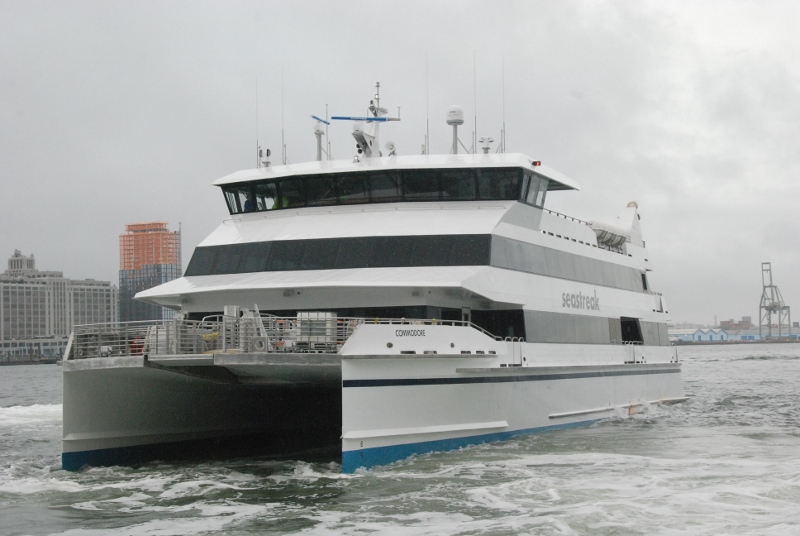From his port bridge station three decks up, ferry captain Dave Clapp kept gentle thrust on the spring lines and an eye on his deckhands, as 447 passengers hopped on board the 8 a.m. boat at Highlands, N.J.
“It has a little more windage, and you’ve got to be careful because it’s so powerful,” Clapp said of the new 150'x40' Seastreak Commodore, at 600 passengers the highest capacity Subchapter K fast passenger vessel ever built in the U.S.
Applying 28% power through Rolls-Royce S63 waterjets, Clapp held the Commodore close as boarding was completed, and could easily see his deckhands working fore and aft from the expanse of wheelhouse windows – a safety feature of the Incat Crowther design that combines speed, capacity and efficiency.
“When you’re up on top (plane) at 35 knots you don’t throw much wake,” said Clapp. The four MTU Tier 3 12V4000M64 diesels collectively deliver up to 7,274 hp, with 1,740 rpm at the top end that achieved 39 knots in sea trials after the vessel was completed in spring 2018 at Gulf Craft, Franklin, La.

Captain Dave Clapp takes the Seastreak Commodore away from the ferry terminal at Highlands, N>J. Kirk Moore photo.
On New York-New Jersey runs, Clapp favors 1,680 rpm. “Saves 200 gallons of fuel a day. Six days a week, it starts to add up,” he said.
With eight boats and more than 200 employees, Seastreak, based in Atlantic Highlands, N.J., operates commuter routes to New York City and seasonal tourist and excursion service to southern New England, including the islands of Martha’s Vineyard and Nantucket off Massachusetts, and up New York’s Hudson River.
Ridership has grown steadily in recent years. Vice president of operations Jack Bevins said Seastreak set specific goals in talking to Incat Crowther designers and Gulf Craft.
“One of the big things was seakeeping ability. That’s very important with the distances we cover, on the New York-New Jersey routes and to Martha’s Vineyard,” said Bevins. “That and passenger capacity.”
Demand for ferry services around New York shows no signs of slowing, amid the region’s mounting traffic congestion and aging public rail transit. The public NYC Ferry system was overwhelmed at times during its spring-summer 2017 debut, exacerbated by breakdowns in regional commuter rail connections and the city subway.
For its New Jersey customers, Seastreak has become more attractive with similar breakdown problems afflicting New Jersey Transit’s Coast Line commuter rail. Those trains trek each way from northern Monmouth County in New Jersey and Manhattan, and can take 90 minutes to two hours. Fast ferries can get up the lower harbor to the Pier 11 Wall Street terminal in less than 45 minutes.
Meanwhile train delays have increased along with ticket prices, and “the differential between NJ Transit and the ferry has narrowed” to around $200 for a monthly pass, said Bevins. “It comes down to ‘What’s your time worth?’”
Moving away from Highlands, the Commodore accelerated smoothly toward Sandy Hook Channel, the machinery sound little more than a low hum on the bridge. At 34 knots the ferry skimmed past baymen in small boats clamming and an occasional porpoise. A wrap-around vista on the second deck with its “wall of windows” that Incat Crowther designed gave passengers an excellent view.

The main cabin features a "wall of windows" with panaromic views for passengers. Kirk Moore photo.
Accommodations include a full service bar, seven restrooms, 526 cabin seats and an additional 110 seats outside.
On the bridge there is a Furuno navigation suite, a FLIR camera for night vision and days of restricted visibility, and video monitors connected to closed circuit cameras monitoring 27 areas on the boat.
The Commodore typically runs its loops at peak commuter hours, twice in the morning and three times late in the day, between the Monmouth County bayshore, Pier 11, and the East 35th Street terminal. The big boat also serves the Martha’s Vineyard route when passengers numbers swell on peak summer days.
“This boat is in high demand, 8 a.m. is the busiest run,” said Brett Chamberlin, Seastreak’s marketing director.
While there is some fall-off in the winter months, “our core ridership tends to stay with us,” said Chamberlain. That demographic is also growing, with workers who live in New York or closer suburbs finding they can live close to the beach and rely on ferries, he said.
“We think given a week’s worth of journeys, you’ll be here for life. We figure on average we save our customers an hour-and-a-half a day,” Chamberlain added. “That was true for me. I used to work in the city for a consulting company at the time I started riding the ferry.
“It was great. I would eat ramen noodles to afford the ferry. Especially on a Friday afternoon … you’d come back riding on the top, with your feet up and a drink. Changes your whole point of view.”

The Seastreak Commodore heads up the East River toward the East 35th Street ferry terminal in Manhattan. Kirk Moore photo.
The Commodore is the biggest and fastest ferry in the Seastreak fleet, but that $14 million project is just part of a long-term recapitalization program. The company has planned and ordered engines for a second vessel, and has been doing midlife refits on its 43-meter class boats that carry 425 passengers.
The work includes new interiors, replacing old four-engine propulsion systems with twin diesels and waterjets, and reshaping the catamaran hulls for better efficiency.
“We removed about 20 tons of weight and were able to reduce about 2,500 horsepower, and maintain the same 35-knot service speed,” said Bevins. The upgrades are well worth the money, he said, because “you could not buy the boats now” given the latest air emission requirements for newbuilds.





